Ever wondered why your HVAC system sometimes struggles to maintain the right temperature? The answer often lies in the expansion valve, a small but crucial component. This device controls the flow of refrigerant between the condenser and evaporator, ensuring your system runs efficiently.
Without a properly functioning valve, your HVAC system can face issues like inconsistent cooling or higher energy bills. For example, a faulty valve might allow too much or too little refrigerant to flow, disrupting the entire system. This can lead to problems like frost on the evaporator or warm air blowing from vents1.
Understanding how these valves work can help you troubleshoot issues and keep your HVAC system in top shape. Whether it’s a thermostatic, electronic, or capillary type, each has its role in maintaining the right pressure and temperature2.
Key Takeaways
- Expansion valves regulate refrigerant flow in HVAC systems.
- They maintain proper pressure and temperature levels.
- Faulty valves can cause inconsistent cooling and higher energy bills.
- Different types, like thermostatic and electronic, serve specific purposes.
- Regular maintenance can prevent valve-related issues.
Getting Started with HVAC Expansion Valves
Are you noticing your HVAC system isn’t cooling as effectively as it used to? This could be due to challenges with refrigerant flow or pressure imbalances. These issues are common and can lead to uneven cooling, higher energy bills, or even system breakdowns3.
Facing Refrigerant Flow Challenges in Your System?
When the refrigerant doesn’t flow properly, your system can’t maintain the right temperature. You might notice frost on the evaporator or warm air blowing from vents. These are early signs of a problem4.
Short-cycling compressors or unusual noises are also red flags. These issues often stem from improper refrigerant flow or incorrect pressure levels. Addressing them early can save you from costly repairs3.
How a Quick Adjustment Can Boost Efficiency
A simple adjustment to the system can improve superheat levels and overall performance. For example, adjusting the refrigerant flow can restore balance and enhance cooling efficiency4.
Industry stats show that timely adjustments can improve HVAC performance by up to 15%. This not only saves energy but also extends the life of your system3.
| Issue | Signs | Solution |
|---|---|---|
| Refrigerant Flow | Uneven cooling, frost on evaporator | Adjust flow or check for blockages |
| Pressure Imbalance | Short-cycling compressor, warm air | Calibrate pressure levels |
| Superheat Levels | High energy bills, system inefficiency | Adjust superheat settings |
By understanding these challenges, you can take proactive steps to keep your HVAC system running smoothly. Many professionals face these issues, so you’re not alone. With the right adjustments, you can restore your system’s efficiency and comfort4.
Understanding the Role of Expansion Valves in Refrigeration
What makes your HVAC system efficient and reliable? The answer lies in the expansion valve, a small but vital component. This device ensures the right amount of refrigerant flows through your system, maintaining optimal pressure and temperature levels.
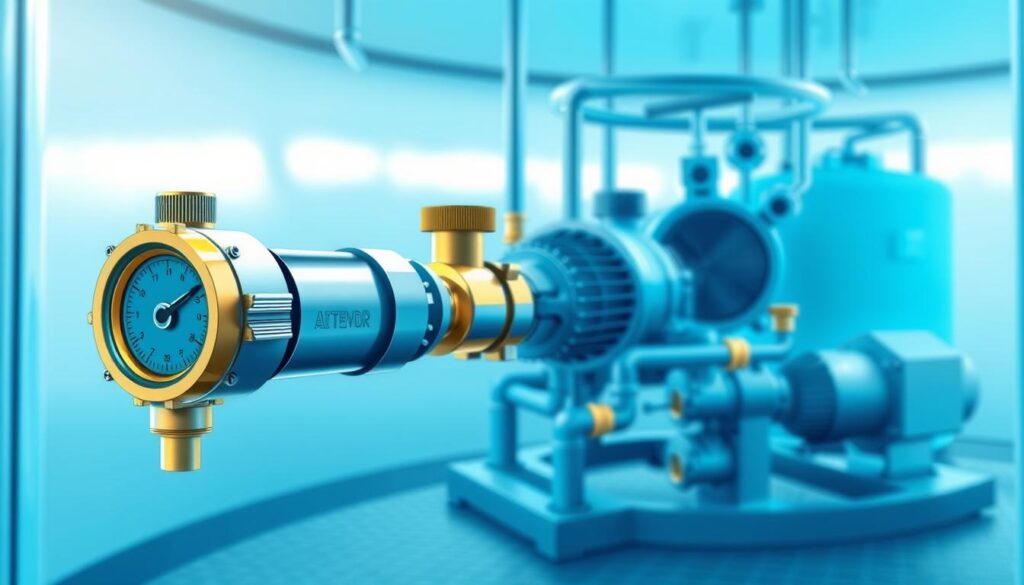
The Science Behind Pressure Reduction and Refrigerant Flow
Think of the refrigerant as water flowing from a mountain stream into a calm lake. The expansion valve acts like a dam, controlling the flow and reducing the pressure as the refrigerant moves from the condenser to the evaporator. This pressure drop is crucial for creating the cooling effect in the evaporator coil.
When the refrigerant enters the evaporator, it changes from a high-pressure liquid to a low-pressure vapor. This transformation absorbs heat, cooling the air that circulates through your system. Without this process, your HVAC wouldn’t be able to maintain a comfortable temperature.
How Expansion Valves Impact Your HVAC Performance
Different valve types, like thermostatic and capillary tubes, play unique roles in regulating refrigerant flow. For example, a thermostatic expansion valve adjusts based on the temperature of the refrigerant, ensuring precise control. This improves energy efficiency and extends the lifespan of your system.
Proper pressure management is key. Industry stats show that well-maintained valves can boost HVAC performance by up to 15%5. Regular maintenance, like checking for blockages or adjusting superheat levels, can prevent issues like frost on the evaporator or warm air from vents6.
By understanding how these valves work, you can ensure your HVAC runs smoothly and efficiently. Next, we’ll explore the different types of expansion valves and their specific applications.
Expansion Valve Types Guide: Exploring TEVs, Capillary Tubes, and More
Why do some HVAC systems perform better than others in varying conditions? The answer often lies in the type of valve they use. These devices control refrigerant flow, ensuring your system adapts to changing demands. Let’s explore the different options available and how they impact your system’s efficiency.
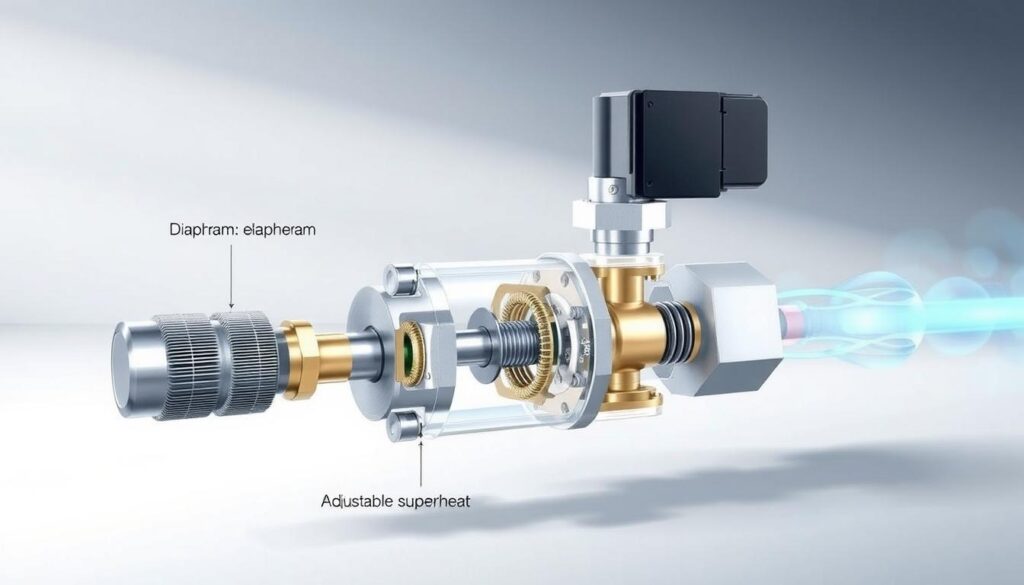
Thermostatic Expansion Valves and Their Functionality
Thermostatic expansion valves, or TEVs, are like the brain of your HVAC system. They use a bulb filled with refrigerant to sense the temperature at the evaporator outlet. This data helps the valve adjust the flow of refrigerant, maintaining optimal pressure and superheat levels7.
For example, if the evaporator gets too cold, the TEV reduces refrigerant flow to prevent frost buildup. This adaptability makes TEVs highly efficient, especially in systems with varying loads8.
Capillary Tubes and Manual Devices Explained in Detail
Capillary tubes are simple yet effective. These long, narrow tubes act like a straw, controlling refrigerant flow based on their size. They’re often used in smaller units due to their low cost and reliability8.
Manual devices, on the other hand, require human intervention to adjust pressure and flow. While they’re less common today, they’re still found in older systems. However, their lack of adaptability can lead to inefficiencies7.
Electronic and Automatic Expansion Solutions in Modern Systems
Electronic expansion valves (EEVs) are the future of HVAC technology. They use sensors and microprocessors to precisely control refrigerant flow. This ensures your system operates at peak efficiency, even in fluctuating conditions8.
Automatic expansion valves (AEVs) maintain consistent pressure but lack the precision of EEVs. They’re ideal for systems with stable loads, but may struggle in variable environments7.
| Type | Function | Best Use |
|---|---|---|
| Thermostatic Expansion Valve | Adjusts flow based on temperature | Systems with varying loads |
| Capillary Tube | Controls flow via tube size | Smaller, cost-effective units |
| Electronic Expansion Valve | Uses sensors for precise control | Modern, high-efficiency systems |
| Automatic Expansion Valve | Maintains consistent pressure | Stable load environments |
Understanding these valve types can help you choose the right one for your system. Whether it’s a TEV, capillary tube, or EEV, each has its unique function and application. By selecting the right device, you can ensure your HVAC system runs smoothly and efficiently.
Practical Tips for Adjusting and Maintaining Your HVAC Expansion Valves
Is your HVAC system not performing as efficiently as it should? Small adjustments to the expansion valve can make a big difference. Proper maintenance ensures your system runs smoothly and saves energy. Let’s dive into some practical tips to help you get started.
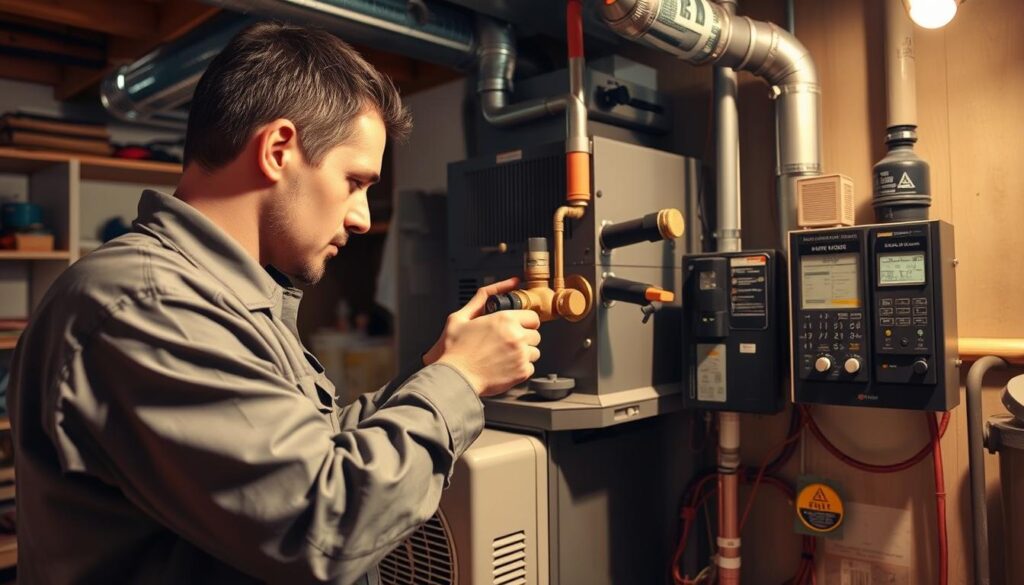
Sensory-Rich Steps to Safely Adjust Expansion Valves
Start by gathering the right tools: a wrench, refrigerant gauge, and thermometer. Safety first—wear gloves and goggles to protect yourself. Locate the adjustment screw on the valve, usually found near the evaporator.
Measure the superheat by checking the suction pressure and temperature at the evaporator outlet. The ideal range is between 5°F to 15°F9. If the superheat is too low, it can flood the compressor; if too high, it indicates inefficiency9.
Make small, incremental adjustments to the screw. Turn it clockwise to increase superheat or counterclockwise to decrease it9. After each adjustment, let the system stabilize for 10-15 minutes before checking again. This prevents overcorrection and ensures accurate results.
Using Industry Stats and Hands-On Experience to Optimize Performance
Industry research shows that proper valve adjustments can improve HVAC efficiency by up to 15%10. For example, one technician prevented compressor short-cycling by carefully calibrating the superheat levels. This not only saved energy but also extended the system’s lifespan.
Regular maintenance is key. Check for blockages in the refrigerant lines and ensure the bulb is securely fastened. Improper placement can lead to inefficiencies10. Routine checks also help identify issues early, preventing costly repairs.
| Issue | Solution | Outcome |
|---|---|---|
| Low Superheat | Increase superheat by turning screw clockwise | Prevents compressor flooding |
| High Superheat | Decrease superheat by turning screw counterclockwise | Improves system efficiency |
| Blocked Lines | Clear refrigerant lines | Restores proper flow |
By following these steps, you can keep your HVAC system running at its best. Small adjustments today can lead to significant savings tomorrow. Don’t wait—take action now to ensure your comfort and efficiency.
Next Steps and Insights for Your HVAC Journey
Ready to take your HVAC knowledge to the next level? Understanding how your system works is the first step toward better performance. Regularly checking superheat levels and ensuring proper refrigerant flow can make a big difference. These small adjustments can improve efficiency and extend the life of your system11.
Consider scheduling a professional maintenance check to identify potential issues early. This proactive approach can save you from costly repairs down the line. Researching HVAC/R training programs can also deepen your expertise and keep you updated on industry trends.
Remember, a well-maintained system not only saves energy but also ensures consistent comfort. Take action today to keep your HVAC running smoothly. Have questions or need advice? Feel free to reach out—we’re here to help!
FAQ
What does an expansion valve do in an HVAC system?
How does a thermostatic expansion valve work?
What’s the difference between a capillary tube and an electronic expansion valve?
Why is superheat important in refrigeration systems?
Can I adjust an expansion valve myself?
What are the advantages of using an electronic expansion valve?
How often should I check my expansion valve?
What happens if an expansion valve fails?
Are there different types of expansion valves for specific applications?
How does an expansion valve impact energy consumption?
Source Links
- Understanding Expansion Valves in HVAC Systems – Today’s Homeowner
- What are the Different Types of Expansion Valves? | Linquip
- Understanding Your Air Conditioner’s Expansion Valve
- Inside Thermal Expansion Valve
- Types Of Expansion Valve In Refrigeration System
- 4.2 Thermal expansion valves (TEVs)
- Understanding HVAC Metering Devices: Types & Functions | Northern Services
- HVAC Metering Devices | Fixed and Modulating | Motili
- Tech Tips for Thermostatic Expansion Valves
- When and How to Adjust a Thermostatic Expansion Valve (TXV) – techtown
- HVAC: Understanding the Basics of Heating, Ventilation, and Air Conditioning


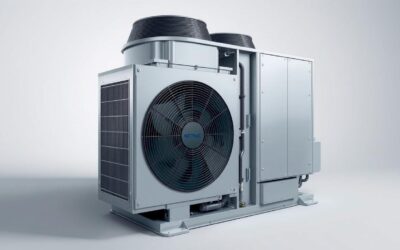
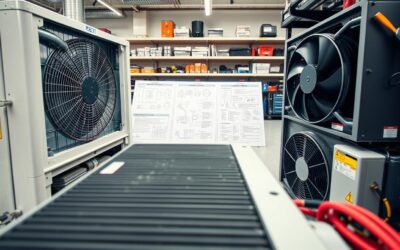
0 Comments